Theodor Dreiser 1871-1945 Early Life Theodore Dreiser was

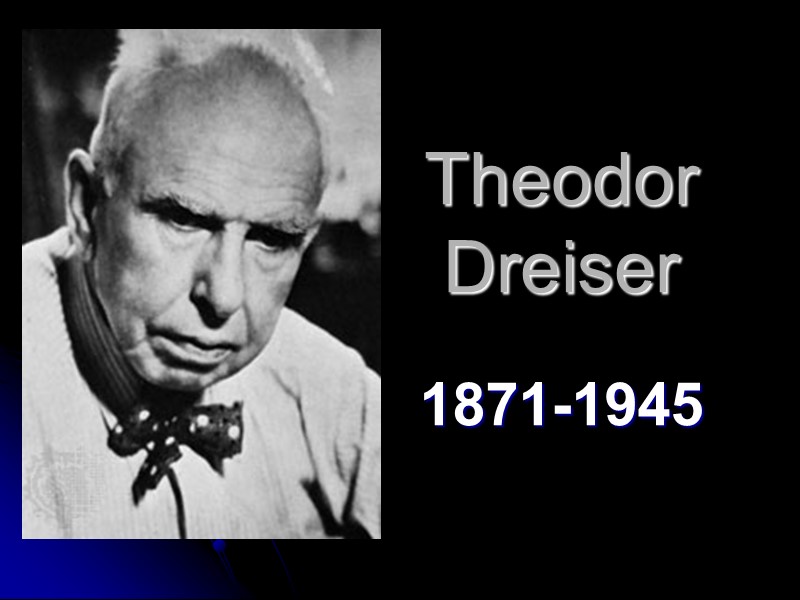
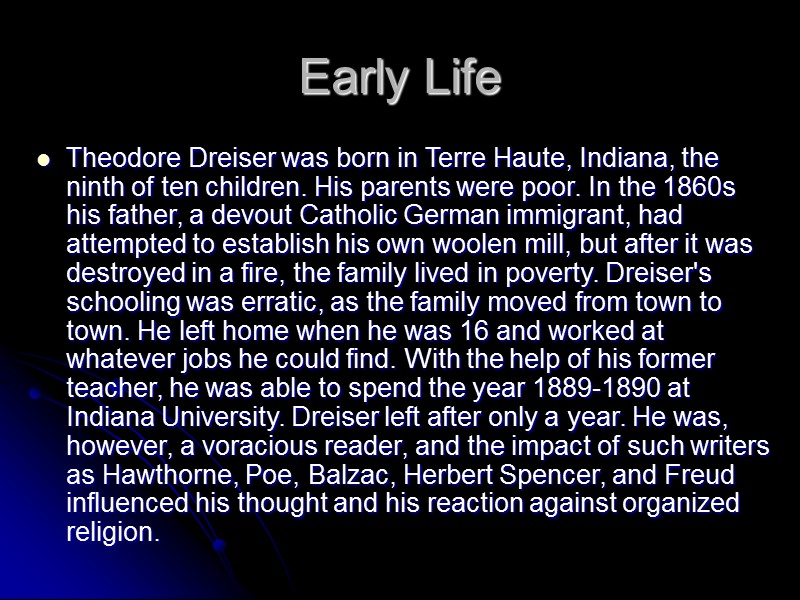
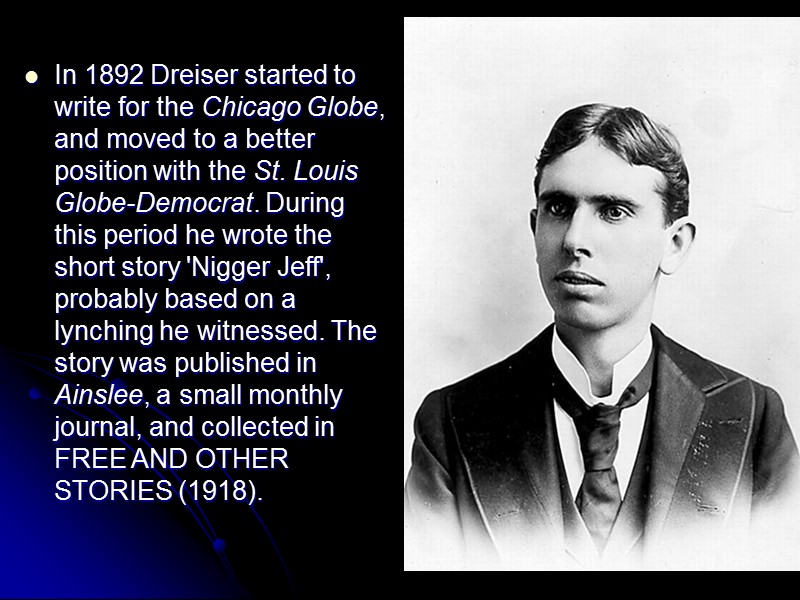
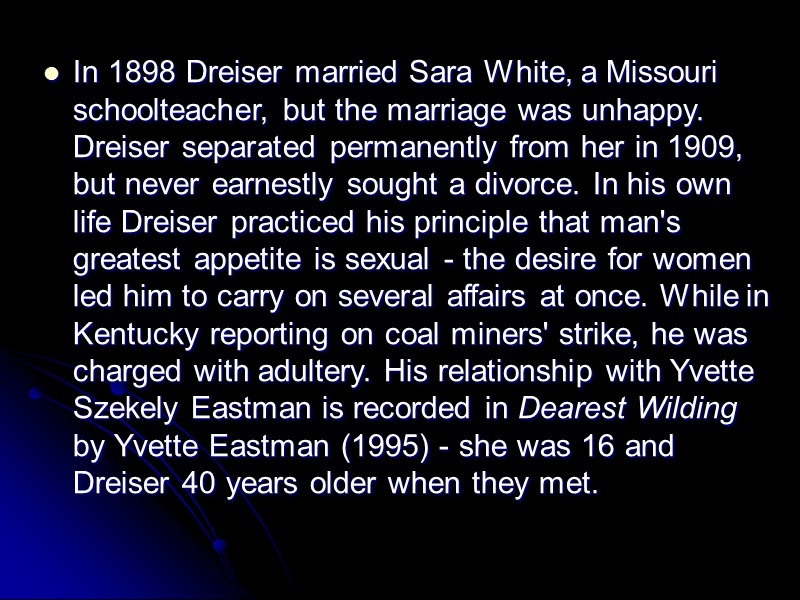
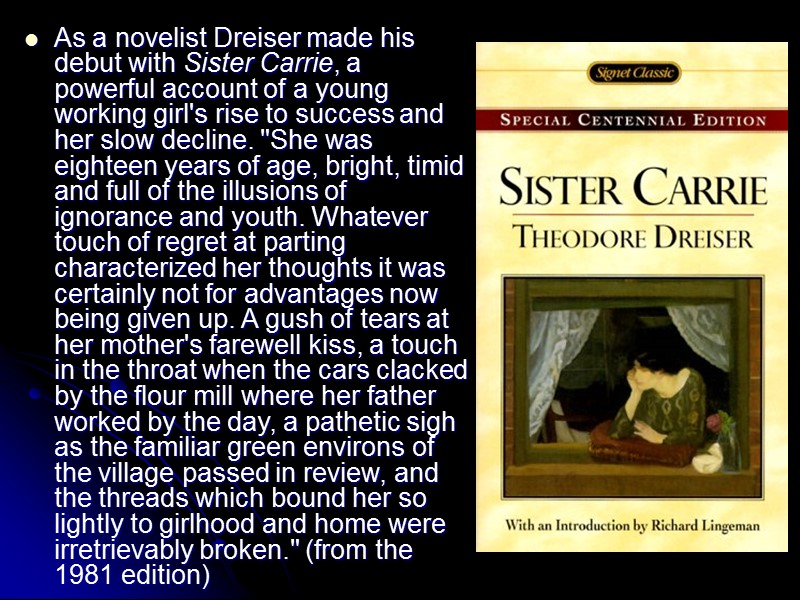
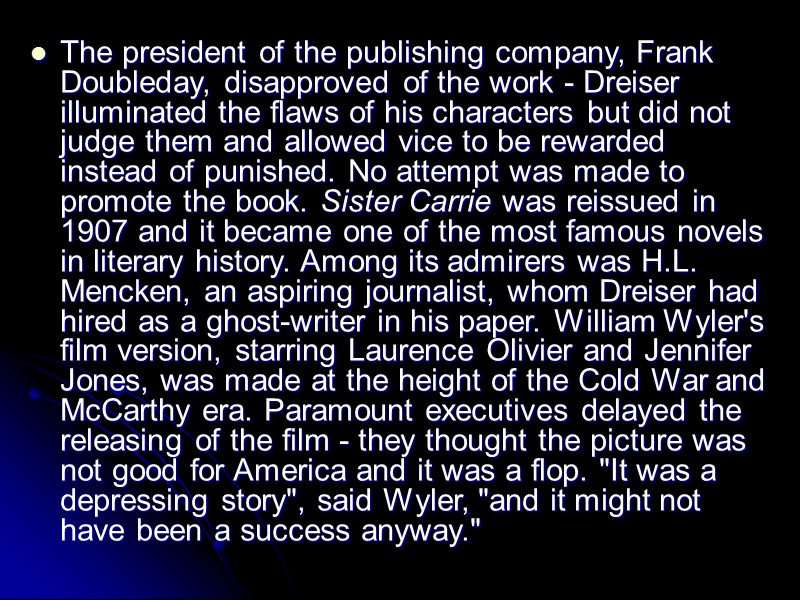
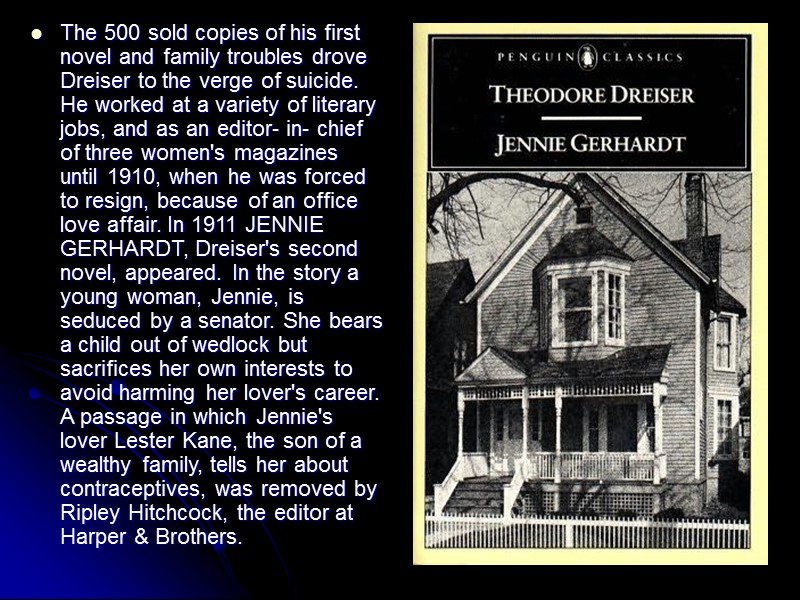
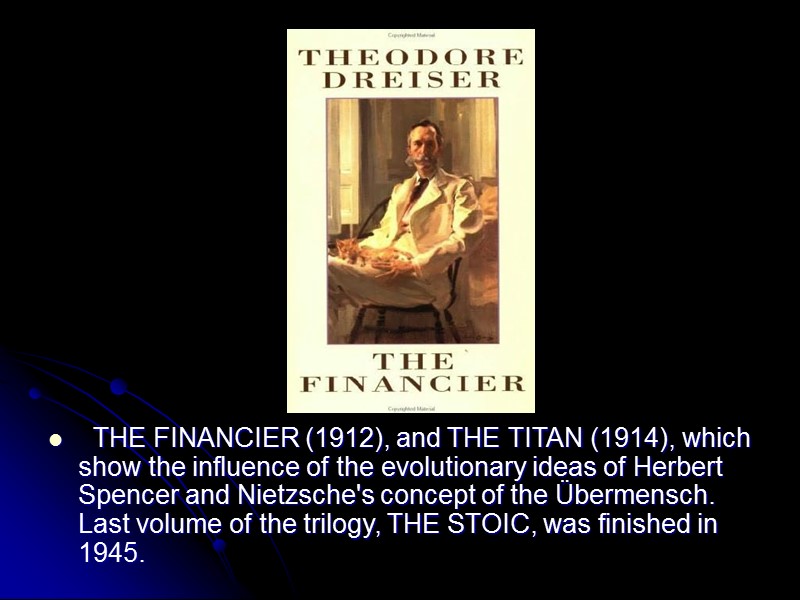
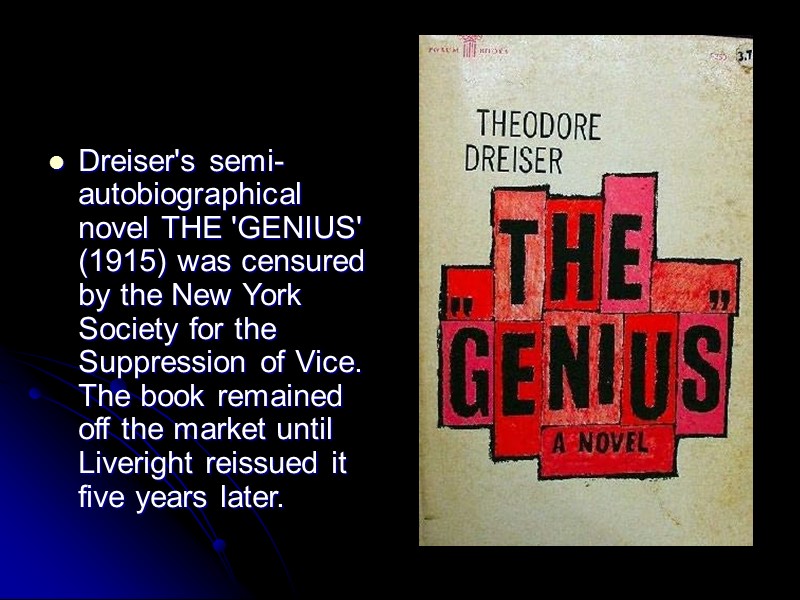
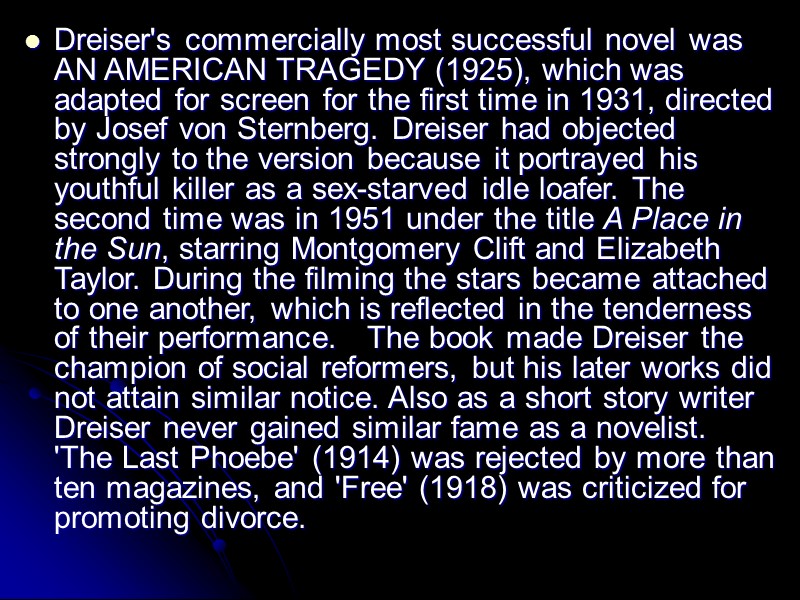
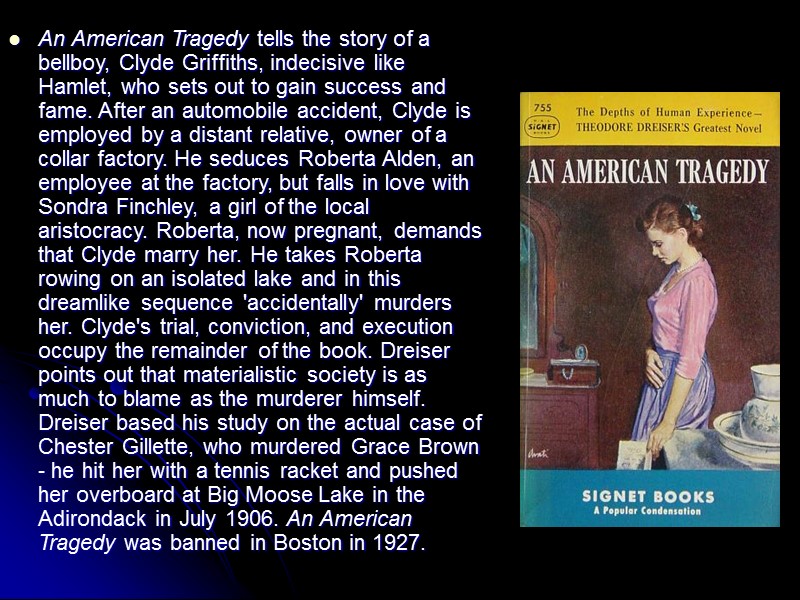
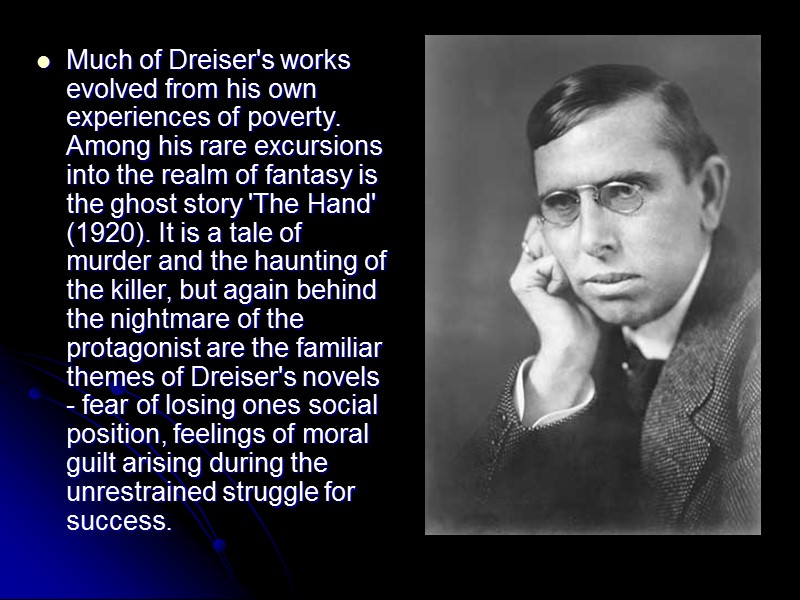
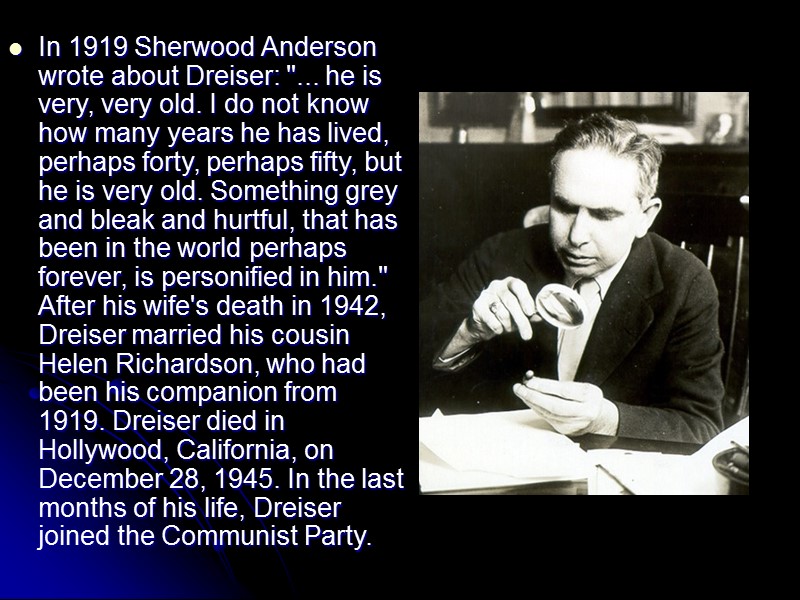
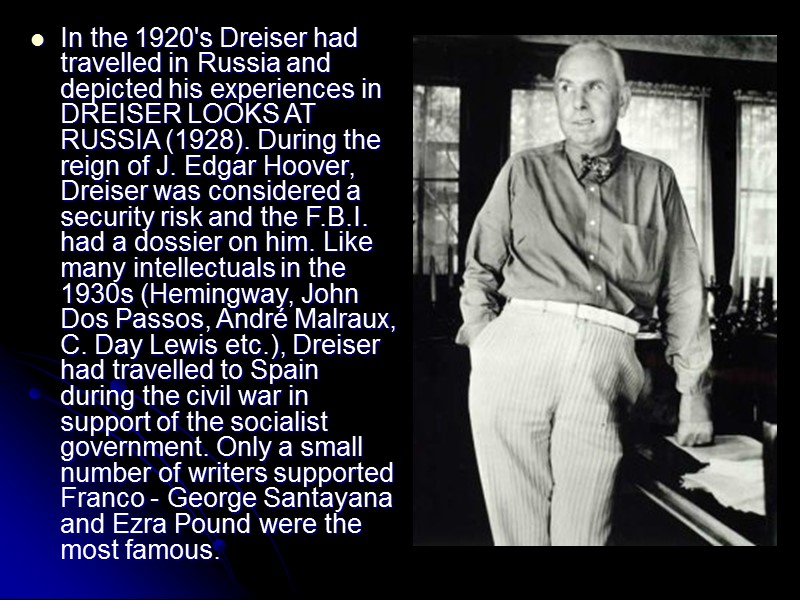
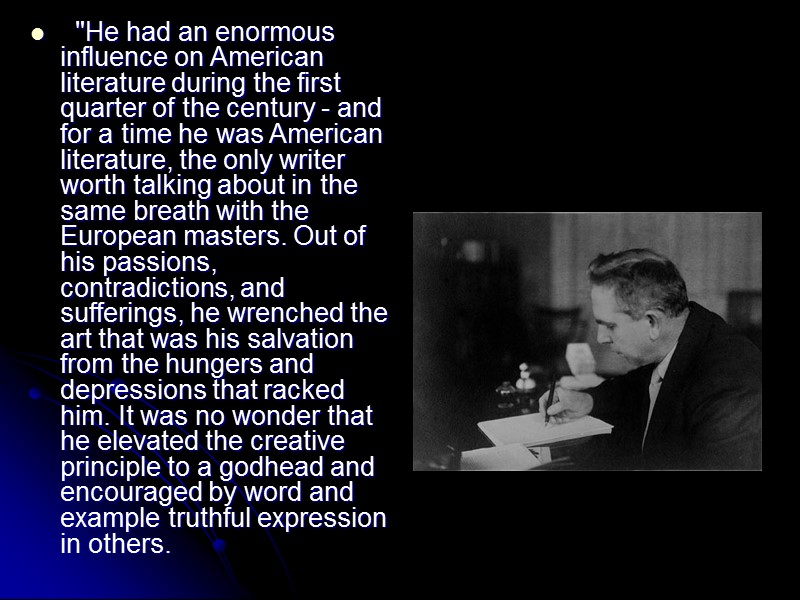
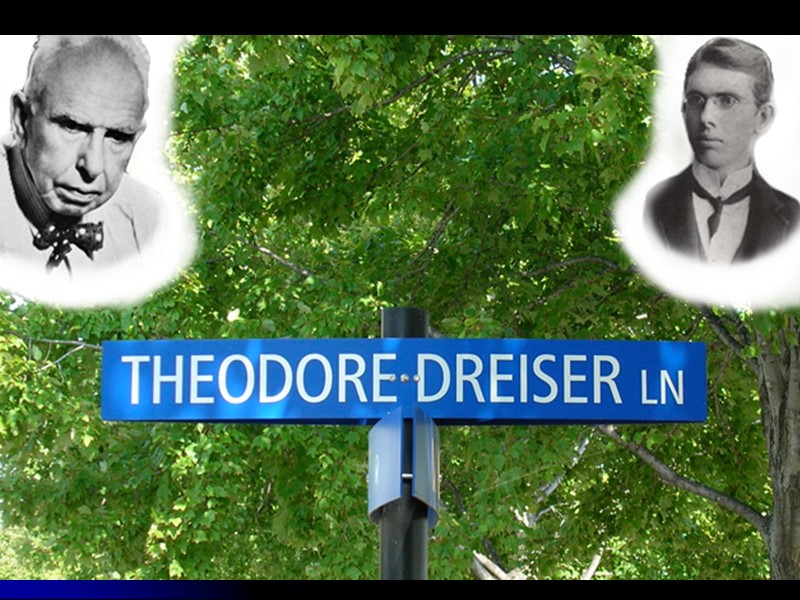
25200-theodor_dreiser.ppt
- Количество слайдов: 16
 Theodor Dreiser 1871-1945
Theodor Dreiser 1871-1945
 Early Life Theodore Dreiser was born in Terre Haute, Indiana, the ninth of ten children. His parents were poor. In the 1860s his father, a devout Catholic German immigrant, had attempted to establish his own woolen mill, but after it was destroyed in a fire, the family lived in poverty. Dreiser's schooling was erratic, as the family moved from town to town. He left home when he was 16 and worked at whatever jobs he could find. With the help of his former teacher, he was able to spend the year 1889-1890 at Indiana University. Dreiser left after only a year. He was, however, a voracious reader, and the impact of such writers as Hawthorne, Poe, Balzac, Herbert Spencer, and Freud influenced his thought and his reaction against organized religion.
Early Life Theodore Dreiser was born in Terre Haute, Indiana, the ninth of ten children. His parents were poor. In the 1860s his father, a devout Catholic German immigrant, had attempted to establish his own woolen mill, but after it was destroyed in a fire, the family lived in poverty. Dreiser's schooling was erratic, as the family moved from town to town. He left home when he was 16 and worked at whatever jobs he could find. With the help of his former teacher, he was able to spend the year 1889-1890 at Indiana University. Dreiser left after only a year. He was, however, a voracious reader, and the impact of such writers as Hawthorne, Poe, Balzac, Herbert Spencer, and Freud influenced his thought and his reaction against organized religion.
 In 1892 Dreiser started to write for the Chicago Globe, and moved to a better position with the St. Louis Globe-Democrat. During this period he wrote the short story 'Nigger Jeff', probably based on a lynching he witnessed. The story was published in Ainslee, a small monthly journal, and collected in FREE AND OTHER STORIES (1918).
In 1892 Dreiser started to write for the Chicago Globe, and moved to a better position with the St. Louis Globe-Democrat. During this period he wrote the short story 'Nigger Jeff', probably based on a lynching he witnessed. The story was published in Ainslee, a small monthly journal, and collected in FREE AND OTHER STORIES (1918).
 In 1898 Dreiser married Sara White, a Missouri schoolteacher, but the marriage was unhappy. Dreiser separated permanently from her in 1909, but never earnestly sought a divorce. In his own life Dreiser practiced his principle that man's greatest appetite is sexual - the desire for women led him to carry on several affairs at once. While in Kentucky reporting on coal miners' strike, he was charged with adultery. His relationship with Yvette Szekely Eastman is recorded in Dearest Wilding by Yvette Eastman (1995) - she was 16 and Dreiser 40 years older when they met.
In 1898 Dreiser married Sara White, a Missouri schoolteacher, but the marriage was unhappy. Dreiser separated permanently from her in 1909, but never earnestly sought a divorce. In his own life Dreiser practiced his principle that man's greatest appetite is sexual - the desire for women led him to carry on several affairs at once. While in Kentucky reporting on coal miners' strike, he was charged with adultery. His relationship with Yvette Szekely Eastman is recorded in Dearest Wilding by Yvette Eastman (1995) - she was 16 and Dreiser 40 years older when they met.
 As a novelist Dreiser made his debut with Sister Carrie, a powerful account of a young working girl's rise to success and her slow decline. "She was eighteen years of age, bright, timid and full of the illusions of ignorance and youth. Whatever touch of regret at parting characterized her thoughts it was certainly not for advantages now being given up. A gush of tears at her mother's farewell kiss, a touch in the throat when the cars clacked by the flour mill where her father worked by the day, a pathetic sigh as the familiar green environs of the village passed in review, and the threads which bound her so lightly to girlhood and home were irretrievably broken." (from the 1981 edition)
As a novelist Dreiser made his debut with Sister Carrie, a powerful account of a young working girl's rise to success and her slow decline. "She was eighteen years of age, bright, timid and full of the illusions of ignorance and youth. Whatever touch of regret at parting characterized her thoughts it was certainly not for advantages now being given up. A gush of tears at her mother's farewell kiss, a touch in the throat when the cars clacked by the flour mill where her father worked by the day, a pathetic sigh as the familiar green environs of the village passed in review, and the threads which bound her so lightly to girlhood and home were irretrievably broken." (from the 1981 edition)
 The president of the publishing company, Frank Doubleday, disapproved of the work - Dreiser illuminated the flaws of his characters but did not judge them and allowed vice to be rewarded instead of punished. No attempt was made to promote the book. Sister Carrie was reissued in 1907 and it became one of the most famous novels in literary history. Among its admirers was H.L. Mencken, an aspiring journalist, whom Dreiser had hired as a ghost-writer in his paper. William Wyler's film version, starring Laurence Olivier and Jennifer Jones, was made at the height of the Cold War and McCarthy era. Paramount executives delayed the releasing of the film - they thought the picture was not good for America and it was a flop. "It was a depressing story", said Wyler, "and it might not have been a success anyway."
The president of the publishing company, Frank Doubleday, disapproved of the work - Dreiser illuminated the flaws of his characters but did not judge them and allowed vice to be rewarded instead of punished. No attempt was made to promote the book. Sister Carrie was reissued in 1907 and it became one of the most famous novels in literary history. Among its admirers was H.L. Mencken, an aspiring journalist, whom Dreiser had hired as a ghost-writer in his paper. William Wyler's film version, starring Laurence Olivier and Jennifer Jones, was made at the height of the Cold War and McCarthy era. Paramount executives delayed the releasing of the film - they thought the picture was not good for America and it was a flop. "It was a depressing story", said Wyler, "and it might not have been a success anyway."
 The 500 sold copies of his first novel and family troubles drove Dreiser to the verge of suicide. He worked at a variety of literary jobs, and as an editor- in- chief of three women's magazines until 1910, when he was forced to resign, because of an office love affair. In 1911 JENNIE GERHARDT, Dreiser's second novel, appeared. In the story a young woman, Jennie, is seduced by a senator. She bears a child out of wedlock but sacrifices her own interests to avoid harming her lover's career. A passage in which Jennie's lover Lester Kane, the son of a wealthy family, tells her about contraceptives, was removed by Ripley Hitchcock, the editor at Harper & Brothers.
The 500 sold copies of his first novel and family troubles drove Dreiser to the verge of suicide. He worked at a variety of literary jobs, and as an editor- in- chief of three women's magazines until 1910, when he was forced to resign, because of an office love affair. In 1911 JENNIE GERHARDT, Dreiser's second novel, appeared. In the story a young woman, Jennie, is seduced by a senator. She bears a child out of wedlock but sacrifices her own interests to avoid harming her lover's career. A passage in which Jennie's lover Lester Kane, the son of a wealthy family, tells her about contraceptives, was removed by Ripley Hitchcock, the editor at Harper & Brothers.
 THE FINANCIER (1912), and THE TITAN (1914), which show the influence of the evolutionary ideas of Herbert Spencer and Nietzsche's concept of the Übermensch. Last volume of the trilogy, THE STOIC, was finished in 1945.
THE FINANCIER (1912), and THE TITAN (1914), which show the influence of the evolutionary ideas of Herbert Spencer and Nietzsche's concept of the Übermensch. Last volume of the trilogy, THE STOIC, was finished in 1945.
 Dreiser's semi-autobiographical novel THE 'GENIUS' (1915) was censured by the New York Society for the Suppression of Vice. The book remained off the market until Liveright reissued it five years later.
Dreiser's semi-autobiographical novel THE 'GENIUS' (1915) was censured by the New York Society for the Suppression of Vice. The book remained off the market until Liveright reissued it five years later.
 Dreiser's commercially most successful novel was AN AMERICAN TRAGEDY (1925), which was adapted for screen for the first time in 1931, directed by Josef von Sternberg. Dreiser had objected strongly to the version because it portrayed his youthful killer as a sex-starved idle loafer. The second time was in 1951 under the title A Place in the Sun, starring Montgomery Clift and Elizabeth Taylor. During the filming the stars became attached to one another, which is reflected in the tenderness of their performance. The book made Dreiser the champion of social reformers, but his later works did not attain similar notice. Also as a short story writer Dreiser never gained similar fame as a novelist. 'The Last Phoebe' (1914) was rejected by more than ten magazines, and 'Free' (1918) was criticized for promoting divorce.
Dreiser's commercially most successful novel was AN AMERICAN TRAGEDY (1925), which was adapted for screen for the first time in 1931, directed by Josef von Sternberg. Dreiser had objected strongly to the version because it portrayed his youthful killer as a sex-starved idle loafer. The second time was in 1951 under the title A Place in the Sun, starring Montgomery Clift and Elizabeth Taylor. During the filming the stars became attached to one another, which is reflected in the tenderness of their performance. The book made Dreiser the champion of social reformers, but his later works did not attain similar notice. Also as a short story writer Dreiser never gained similar fame as a novelist. 'The Last Phoebe' (1914) was rejected by more than ten magazines, and 'Free' (1918) was criticized for promoting divorce.
 An American Tragedy tells the story of a bellboy, Clyde Griffiths, indecisive like Hamlet, who sets out to gain success and fame. After an automobile accident, Clyde is employed by a distant relative, owner of a collar factory. He seduces Roberta Alden, an employee at the factory, but falls in love with Sondra Finchley, a girl of the local aristocracy. Roberta, now pregnant, demands that Clyde marry her. He takes Roberta rowing on an isolated lake and in this dreamlike sequence 'accidentally' murders her. Clyde's trial, conviction, and execution occupy the remainder of the book. Dreiser points out that materialistic society is as much to blame as the murderer himself. Dreiser based his study on the actual case of Chester Gillette, who murdered Grace Brown - he hit her with a tennis racket and pushed her overboard at Big Moose Lake in the Adirondack in July 1906. An American Tragedy was banned in Boston in 1927.
An American Tragedy tells the story of a bellboy, Clyde Griffiths, indecisive like Hamlet, who sets out to gain success and fame. After an automobile accident, Clyde is employed by a distant relative, owner of a collar factory. He seduces Roberta Alden, an employee at the factory, but falls in love with Sondra Finchley, a girl of the local aristocracy. Roberta, now pregnant, demands that Clyde marry her. He takes Roberta rowing on an isolated lake and in this dreamlike sequence 'accidentally' murders her. Clyde's trial, conviction, and execution occupy the remainder of the book. Dreiser points out that materialistic society is as much to blame as the murderer himself. Dreiser based his study on the actual case of Chester Gillette, who murdered Grace Brown - he hit her with a tennis racket and pushed her overboard at Big Moose Lake in the Adirondack in July 1906. An American Tragedy was banned in Boston in 1927.
 Much of Dreiser's works evolved from his own experiences of poverty. Among his rare excursions into the realm of fantasy is the ghost story 'The Hand' (1920). It is a tale of murder and the haunting of the killer, but again behind the nightmare of the protagonist are the familiar themes of Dreiser's novels - fear of losing ones social position, feelings of moral guilt arising during the unrestrained struggle for success.
Much of Dreiser's works evolved from his own experiences of poverty. Among his rare excursions into the realm of fantasy is the ghost story 'The Hand' (1920). It is a tale of murder and the haunting of the killer, but again behind the nightmare of the protagonist are the familiar themes of Dreiser's novels - fear of losing ones social position, feelings of moral guilt arising during the unrestrained struggle for success.
 In 1919 Sherwood Anderson wrote about Dreiser: "... he is very, very old. I do not know how many years he has lived, perhaps forty, perhaps fifty, but he is very old. Something grey and bleak and hurtful, that has been in the world perhaps forever, is personified in him." After his wife's death in 1942, Dreiser married his cousin Helen Richardson, who had been his companion from 1919. Dreiser died in Hollywood, California, on December 28, 1945. In the last months of his life, Dreiser joined the Communist Party.
In 1919 Sherwood Anderson wrote about Dreiser: "... he is very, very old. I do not know how many years he has lived, perhaps forty, perhaps fifty, but he is very old. Something grey and bleak and hurtful, that has been in the world perhaps forever, is personified in him." After his wife's death in 1942, Dreiser married his cousin Helen Richardson, who had been his companion from 1919. Dreiser died in Hollywood, California, on December 28, 1945. In the last months of his life, Dreiser joined the Communist Party.
 In the 1920's Dreiser had travelled in Russia and depicted his experiences in DREISER LOOKS AT RUSSIA (1928). During the reign of J. Edgar Hoover, Dreiser was considered a security risk and the F.B.I. had a dossier on him. Like many intellectuals in the 1930s (Hemingway, John Dos Passos, André Malraux, C. Day Lewis etc.), Dreiser had travelled to Spain during the civil war in support of the socialist government. Only a small number of writers supported Franco - George Santayana and Ezra Pound were the most famous.
In the 1920's Dreiser had travelled in Russia and depicted his experiences in DREISER LOOKS AT RUSSIA (1928). During the reign of J. Edgar Hoover, Dreiser was considered a security risk and the F.B.I. had a dossier on him. Like many intellectuals in the 1930s (Hemingway, John Dos Passos, André Malraux, C. Day Lewis etc.), Dreiser had travelled to Spain during the civil war in support of the socialist government. Only a small number of writers supported Franco - George Santayana and Ezra Pound were the most famous.
 "He had an enormous influence on American literature during the first quarter of the century - and for a time he was American literature, the only writer worth talking about in the same breath with the European masters. Out of his passions, contradictions, and sufferings, he wrenched the art that was his salvation from the hungers and depressions that racked him. It was no wonder that he elevated the creative principle to a godhead and encouraged by word and example truthful expression in others.
"He had an enormous influence on American literature during the first quarter of the century - and for a time he was American literature, the only writer worth talking about in the same breath with the European masters. Out of his passions, contradictions, and sufferings, he wrenched the art that was his salvation from the hungers and depressions that racked him. It was no wonder that he elevated the creative principle to a godhead and encouraged by word and example truthful expression in others.


